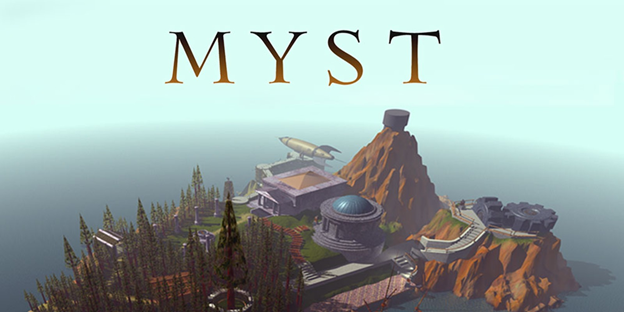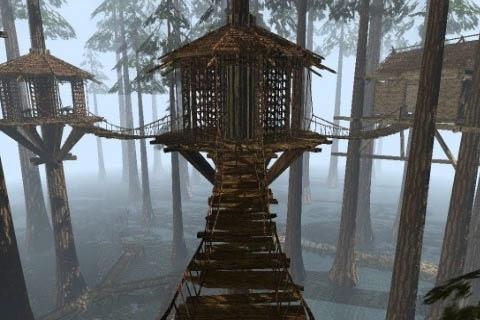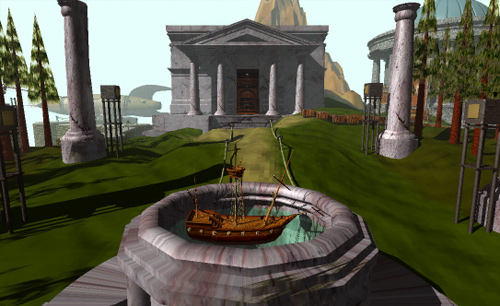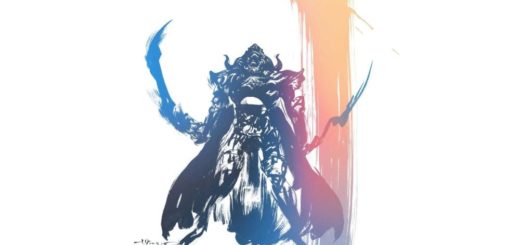Classic Callback: MYST

The first time I played MYST, I was laying on my stomach in front of my parents’ ancient monitor, my face inches away from the screen. At nine years old, my impetus for interacting with it was the way I had seen the game captivate my mother, who otherwise mostly stayed away from computers. Curious, I wanted to know what it was about this game that was so arresting, and the box art wasn’t giving me any clues. Within 20 minutes of starting up the software, I had to step away. Men were talking to me from inside books. Dark, atmospheric music raised the hairs on my neck. Puzzles were presented without explanations or clues, cruelly leaving their solutions entirely up to my pre-teen imagination. I was very thoroughly creeped out by this new world with its lack of tutorials or friendly faces. What had absorbed my mom had absolutely repulsed me.
My first brush with the 1993 computer game by Cyan, Inc, would not be my last, however. I came back to it in middle school, unable to forget the first game I had played that was neither educational nor a platformer. This moody puzzler was the best selling computer game for nine years until it was finally dethroned by THE SIMS. It has been ported to everything, from the Philips CD-i to the DS and mobile. It spawned five sequels and three companion novels, as well as an entire genre of gaming. There was a reason for this popularity, and I intended to find out why.

I feel like this is the sort of world where you have to put leech socks on your packing lyst
Developed primarily by Cyan founders Rand and Robyn Miller, MYST opens with the player character falling through a book onto a curious island dotted with mysterious structures. Throughout the game, this protagonist, known only as “The Stranger,” must travel to other worlds via “linking books” like the one that brought you here, restoring the pages to two of the books in the island’s library. Each book contains one of a pair of brothers who have been trapped inside a world in the book. Each will declare that this is their father’s island and blame the other for his imprisonment, and it is up to you to decide whether you will help either, if at all.
The simple premise comes with equally simple mechanics. The intuitive nature of exploring the island is the biggest strength of the gameplay. The original game was developed on a basic programming application, using pre-rendered assets and a point-and-click style of interaction. There’s no HUD or mini-map,meaning there’s a legitimate sense of wonder everytime you discover a hidden area or solve a puzzle. These accomplishments are yours alone, reinforcing the allure of your investigation.
This lack of hand-holding can also be found in the dialogue (or lack thereof) in the game. Outside of the opening monologue, The Stranger never speaks, and the only voiced sequences involve brief scenes with the trapped brothers and their father. Aside from some scattered writings, the only explanation for what is going on is left entirely to your own fancy. In every sense that matters, you are alone with your thoughts on the island. This creates an atmosphere of mystery that leaves the player feeling extremely isolated and focuses the gameplay on the visual interaction with the world.

A small boat. I was pyst when I realized I couldn’t sail it
MYST’s minimalist presentation contributes to one of the most compelling explorations in the medium. The lack of a fully formed player character instead posits you, the player, in the realm of the game: an incredibly personal experience, relying on observation of the player to take visual exposition and form the full story inside your head as you play. This creates an atmosphere of mystery that isolates the player, allowing them to focus entirely on interacting with the environment. Some of the challenges are frustratingly difficult, and may drive you to consult a walkthrough, but the quiet tone of the game makes participating in searching for these answers exciting. You feel a true sense of reward every time you solve a challenge that allows you to look around a new part of the island, because unlike its predecessors, MYST doesn’t follow an established protagonist solving aspects of a linear story. Every interaction in the world of MYST is a choice made by the player, and due to the lack to an avatar, exposition, or help from the universe, it is ultimately the player themselves who is the hero of this adventure.
This deviance from prior adventure and puzzle games, specifically the lack of text, is another quality that added to MYST’s success. Text-based computer games like ZORK and COLOSSAL CAVE ADVENTURE translated tabletop gaming onto the limited hardware of ‘70s computers, while point-and-click adventures like The King’s Quest series and THE SECRET OF MONKEY ISLAND revolutionized what a computer gaming experience could be with the addition of solid visuals and strong art design. But all of those were heavily reliant on text, in some form or another, to help build the story. MYST was the exact opposite. While the player is welcome to read the smattering of hidden documents to learn the backstory of the world, they are unnecessary for solving puzzles and progressing. Instead, the game pioneered player interaction as the driving force within a narrative, while emphasizing the visual medium in participatory action. Observation, rather than reading comprehension, is the skill required for success. Your wits alone are what give you the clues to solve the puzzles in the game.

I was not prepared for this at all at age nine, but I got the gyst
And it is that freedom that is the biggest legacy of MYST. The open-ended gameplay, with no combat, no time limits, no health bar, just wandering, leads to exactly the sort of world building that can only be accomplished by video games. In every aspect, the game offers a degree of freedom never before seen in the medium. The beauty of the artform is its ability to create totally imaginary worlds, and MYST was one of the first to capture that visually.
MYST’s influence can still be felt in many modern games; walking simulators in particular take the same exploratory gameplay style and use it to weave a variety of tales. Take 2016’s THE WITNESS, a puzzler directly inspired by MYST that focuses on nonverbal mechanics by way of puzzles and little exposition to tell a story. Cyan also released a game in 2016 called OBDUCTION, billed as a “spiritual successor” to MYST. But there is also DEAR ESTHER, EVERYBODY’S GONE TO THE RAPTURE, GONE HOME, and dozens of other titles which each let you discover the secrets of the world at your own pace. All of these games owe their style to this past game.

I would exyst in a pre rendered 3D computer game from the ‘90s if my house looked like this.
Even MYST’s FMV sequences, 25 years later, have aged well, their low quality footage complementing the static-ridden windows of the books the brothers look out at you from. While the entire graphic and aesthetic nature of the world is definitely within the confines of ‘90s technology, and looks its age, the theme of discovery is not diminished by graphical limitations. Instead, it merely adds on to the character of the game. Cyan did release REALMYST: MASTERPIECE EDITION on the Unity engine in 2014, which is gorgeous and definitely adds to the feeling of freedom and exploration the game offers.That being said, the original graphics will always hold a certain place in my heart. Nostalgia is a factor in my the love of the game, but the dated image still efficiently tells the story while contributing a specific sci-fi tone.
The overall success of MYST has long been appreciated in the gaming world. Usually as technology develops, older ideas are left by the wayside, but the popularity of MYST has allowed it to endure even today. Even though the game spooked me the first time I sat down to play it, I was drawn back by the allure of the game and the puzzles that did not contain an easy answer. MYST was able to stretch its limitations and create a fully immersive world, and that impact and experience is why it is still one of my favorite gaming experiences today.
MYST and its many remakes are available on PC, Mobile, DS, 3DS, PlayStation, PSP, Atari Jaguar CD, 3DO, CD-i, and Saturn.



